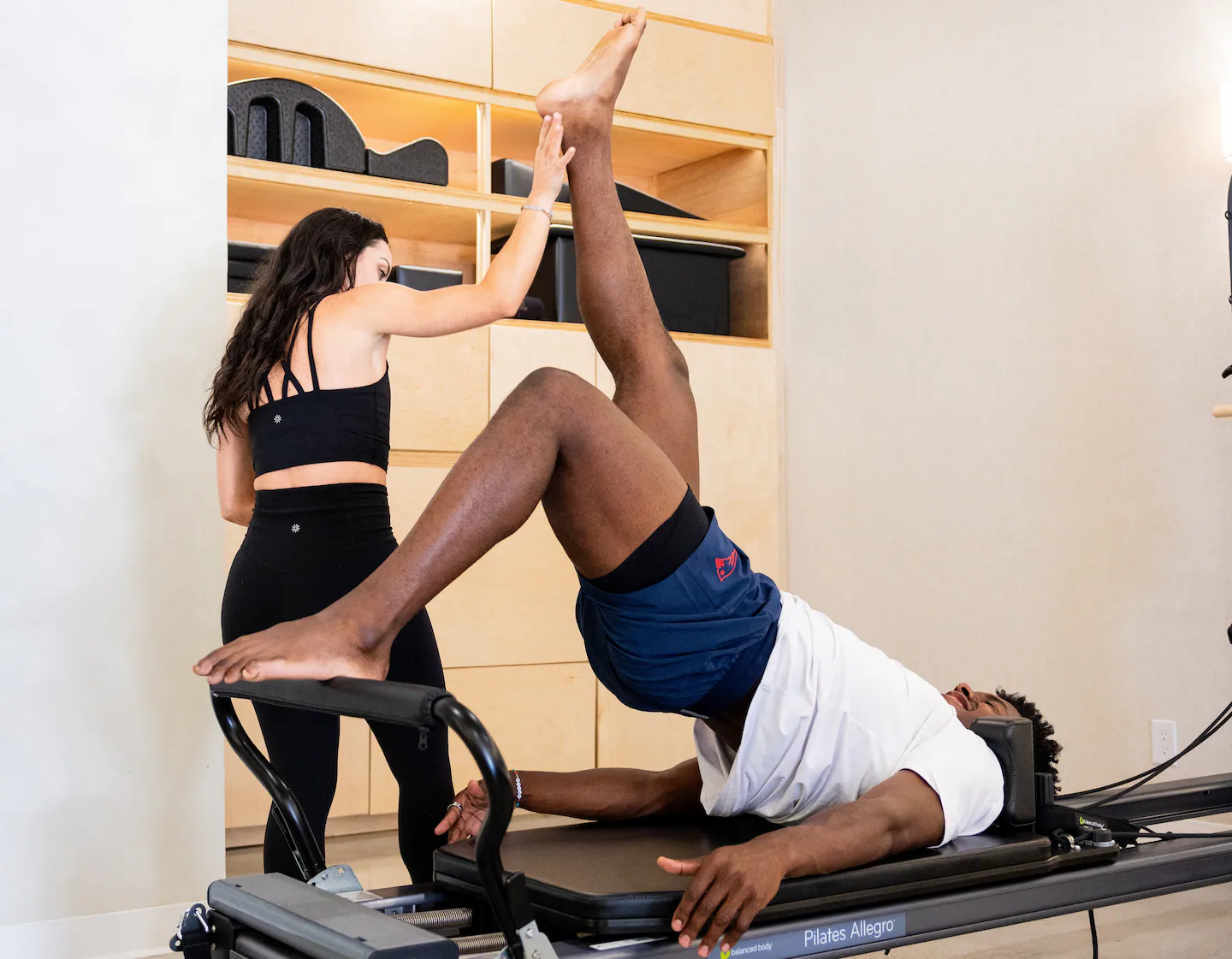
“I was humbled quickly, very, very quickly,” Gonzalez recalled. “It’s a lot harder than it looks. Me, being an athlete my whole life and thinking I can do things, I get on the reformer and I don’t know what happens. My legs, my arms are shaking. It was pretty crazy.”
Although Gonzalez didn’t love the workout — in fact, he says he “hated it” — he continued to practice it throughout his recovery. Even after he was able to return to his usual training, Gonzalez made sure to integrate Pilates into his weekly schedule because of its benefits.
“I definitely feel like I can control a lot more of the smaller muscles better than before,” he said.
Gonzalez has joined the small but growing contingent of NFL players that have embraced Pilates as a form of cross-training.
Members of the Chiefs defensive line often go to the studio as a group. Rams outside linebacker Jared Verse referred to Pilates as teammate Byron Young’s “magic power.” Commissioner Roger Goodell estimates about 10 percent of the league is practicing Pilates, with that number expected to increase in the coming years.
Gonzalez, wide receiver Stefon Diggs, safety Jaylinn Hawkins, linebacker Anfernee Jennings, and cornerback Marcus Jones are among the Patriots that have given Pilates a try.
“It blew me away, to be honest,” Hawkins said. “It actually was more than I expected. I didn’t know it was going to be this beneficial. I would recommend it to anybody who plays football or just anybody. It’s life-changing for me.”
There are three primary Pilates apparatuses that the players use.
The most popular is the reformer, which features a sliding carriage with straps and resistance springs. Exercises include hip bridges for spine articulation, teasers for balance as well as core stability, and arm circles for shoulder mobility.
The other two are the trapeze table, known as the Cadillac, which features bars for suspending oneself in the air, and the chair, which features a pedal attached to resistance springs.
No matter the equipment, however, the foundation always stays the same.
Pilates, which primarily focuses on mind-body connection and core strength, has six principles: breathing, concentration, centering, control, precision, and flow.
“All of the Pilates principles can be applied to football,” said instructor Kelly Beriau, who works with Hawkins at Boston Body Pilates on Newbury Street.
Beriau will often guide Hawkins through active stretching sessions, which sound much easier than they are. She caters movements to each individual’s needs — prioritizing spinal mobility and internal hip rotation with Hawkins — but nearly all clients come away with improved flexibility, muscle stability, and overall body alignment and control.
“Football players already have such great body awareness,” Beriau said. “In Pilates, you have to pay attention to what’s moving, what isn’t moving. Where am I initiating from? That millisecond and the firing of your brain and your muscles is so much more sophisticated compared to any other fitness modality.”
Like Gonzalez, most of the Patriots were initially taken aback by the difficulty of Pilates.
“It was hard,” Hawkins said. “Don’t get it twisted.”
But they all also acknowledged the benefits, which have kept them coming back for more.
“If you haven’t done Pilates, that [expletive] is not easy,” Diggs said. “I just wanted a stronger core and better mobility. I actually enjoyed hanging upside down. It helped me decompress my back and my body. I don’t know the science behind it, but it felt good.”
“You have way more respect after you do it,” Jones added. “It has a lot to do with stretching and strengthening our muscles. Most of the time, when we’re working out, we’re just trying to strengthen. It’s not really from the sense of stretch-strengthening. No matter how much you weigh, you’re going to end up shaking. It’s just one of those situations that is uncomfortable for the body. But it can be much-needed.”
The principles of Pilates are reminiscent of former Patriots quarterback Tom Brady’s “TB12 Method,” an approach to wellness that de-emphasizes heavy weight lifting and stresses the importance of pliability in order to reach peak performance.
Nicky Lal, a Los Angeles-based instructor who trains dozens of professional athletes, including former Celtic Jrue Holiday, echoed Brady’s sentiment, stressing the need for mindful training.
“They’re just used to a very archaic way of movements,” Lal said. “It’s just lift, lift, lift. But on the field, you’re not just lifting up a body and tossing them. You’re tackling full-force, and some people are getting hit left, right, side to side.
“I’m trying to train them for the sport in the Pilates room. I’m going to put them in every compromised position that they get strong in, so that when they get pushed and pulled in a direction and get hit in a place, their body is able to adapt to that movement.”
It can be difficult for the Patriots to find time for Pilates during the season.
Hawkins, whose wife Jayda is becoming a certified instructor, owns a reformer, so he’s able to practice as often as he pleases. He’ll typically visit Beriau on Tuesdays and then go through stretches with Jayda on a Friday night.
Jones, meanwhile, plans on making it more of a priority after the season, especially after seeing how the improved body control and core stability can translate to the field.
Gonzalez, too, saves Pilates for his offseason, usually jumping into it right after the season in order to help his body recover. He’ll continue going once or twice a week up until OTAs — despite his love for the workout not changing since his very first workout.
“The core burns,” Gonzalez said. “When the session is over is my favorite.”